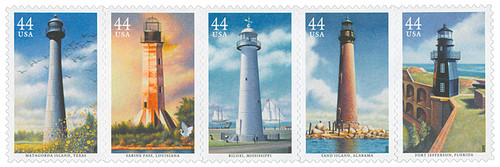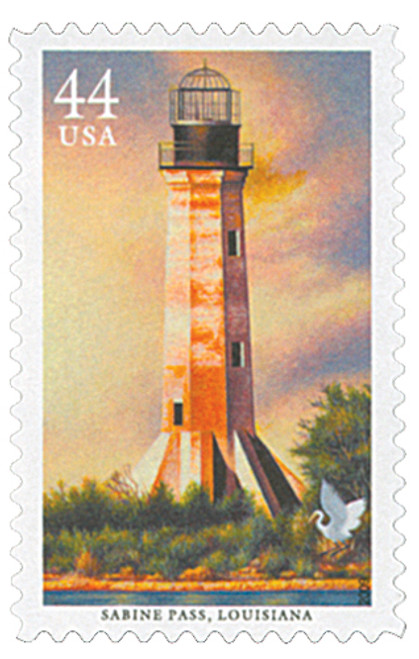
# 4411 FDC - 2009 44c Gulf Coast Lighthouses: Biloxi, Mississippi
Gulf Coast Lighthouses
Biloxi, Mississippi
Issue Date: July 23, 2009
City: Biloxi, MS
In 1847, Representative Jefferson Davis of Mississippi sponsored legislation to authorize the construction of three lighthouses in his home state.
After serving as the President of the Confederate States of America, Davis retreated to his Mississippi estate and passed away within the shadow of the Biloxi lighthouse in 1889. Today, the Biloxi landmark proposed by Davis is the only one of more than ten lighthouses originally built to mark the Mississippi coastline.
The Biloxi lighthouse’s longevity may be due to its construction. It consists of metal plates that are bolted together to form a metal wrapper around a brick liner. Completed in 1848, it was the first cast-iron lighthouse tower in the South. After the Civil War, the lighthouse was painted with black coal tar to protect it from rust, leading to a legend that the tower was painted black to mourn the death of Abraham Lincoln.
Women figure prominently in the Biloxi lighthouse’s lengthy history. It had more female keepers for more years than any other lighthouse in the United States. Mary Reynolds served from 1854 to 1866. Her male replacement died during his first year of service and was replaced by his wife, Maria Younghans. Her daughter, Miranda, kept the Biloxi lighthouse until electricity was introduced in 1929.
Gulf Coast Lighthouses
Biloxi, Mississippi
Issue Date: July 23, 2009
City: Biloxi, MS
In 1847, Representative Jefferson Davis of Mississippi sponsored legislation to authorize the construction of three lighthouses in his home state.
After serving as the President of the Confederate States of America, Davis retreated to his Mississippi estate and passed away within the shadow of the Biloxi lighthouse in 1889. Today, the Biloxi landmark proposed by Davis is the only one of more than ten lighthouses originally built to mark the Mississippi coastline.
The Biloxi lighthouse’s longevity may be due to its construction. It consists of metal plates that are bolted together to form a metal wrapper around a brick liner. Completed in 1848, it was the first cast-iron lighthouse tower in the South. After the Civil War, the lighthouse was painted with black coal tar to protect it from rust, leading to a legend that the tower was painted black to mourn the death of Abraham Lincoln.
Women figure prominently in the Biloxi lighthouse’s lengthy history. It had more female keepers for more years than any other lighthouse in the United States. Mary Reynolds served from 1854 to 1866. Her male replacement died during his first year of service and was replaced by his wife, Maria Younghans. Her daughter, Miranda, kept the Biloxi lighthouse until electricity was introduced in 1929.











